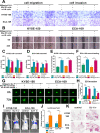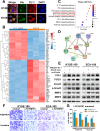Irradiation induces DJ-1 secretion from esophageal squamous cell carcinoma cells to accelerate metastasis of bystander cells via a TGF-β1 positive feedback loop
- PMID: 36008860
- PMCID: PMC9413943
- DOI: 10.1186/s13046-022-02471-6
Irradiation induces DJ-1 secretion from esophageal squamous cell carcinoma cells to accelerate metastasis of bystander cells via a TGF-β1 positive feedback loop
Abstract
Background: Radiation-induced bystander effect (RIBE) can promote tumor metastasis contributing to the failure of radiotherapy for esophageal squamous cell carcinoma (ESCC). Aberrant expression of DJ-1 has been identified in ESCC; however, the relationship between DJ-1 and RIBE in ESCC remains unknown.
Methods: We detected DJ-1 in the serum and cell supernatants by enzyme-linked immunosorbent assay (ELISA) and evaluated tumor metastasis by phenotypic experiments in vivo and in vitro. RNA-seq, mass spectrometry, western blot (WB), immunoprecipitation (IP), and dual-luciferase reporter assays were performed to explore the underlying mechanisms.
Results: DJ-1 was highly expressed in the serum of patients with ESCC receiving radiotherapy and was significantly overexpressed in the medium of ESCC cells receiving irradiation. DJ-1 promoted tumor metastasis via the TGF-β1 pathway. Mechanistic studies revealed that DJ-1 bound to HSC70 to promote Smad3 phosphorylation and nuclear aggregation in a protein-interaction manner, which activated the transcription of Thrombospondin-1 (TSP1). Subsequently, the activation of TGF-β1 by TSP1 re-promoted Smad3 phosphorylation and nuclear aggregation, constituting a positive feedback loop to strengthen the metastasis of ESCC cells, which was effectively blocked by LY2109761 and LSKL. Moreover, higher levels of serum DJ-1 in patients with ESCC were related to a poorer prognosis of radiotherapy.
Conclusions: Irradiation can induce ESCC cells secreting DJ-1. Secreted DJ-1 enters bystander cells to initiate activation of the TGF-β1 pathway via the DJ-1/HSC70/Smad3 signaling axis. The TSP1/TGF-β1/Smad3 positive feedback pathway constitutes the core pathway that promotes ESCC metastasis. DJ-1 is a useful biomarker for predicting the efficacy of radiotherapy and a potential therapeutic target for reversing RIBE in ESCC. Schematic diagram showing the underlying mechanism that irradiation-induced secretion of DJ-1 accelerates the metastasis of bystander ESCC cells.
Keywords: DJ-1; Esophageal squamous cell carcinoma; HSC70; Radiation-induced bystander effect; Smad3; TGF-β1; TSP1; Tumor metastasis.
© 2022. The Author(s).
Conflict of interest statement
The authors declare that they have no competing interests.
Figures









Similar articles
-
ATAD2 interacts with C/EBPβ to promote esophageal squamous cell carcinoma metastasis via TGF-β1/Smad3 signaling.J Exp Clin Cancer Res. 2021 Mar 23;40(1):109. doi: 10.1186/s13046-021-01905-x. J Exp Clin Cancer Res. 2021. PMID: 33757572 Free PMC article.
-
CD82/KAI1 inhibits invasion and metastasis of esophageal squamous cell carcinoma via TGF-β1.Eur Rev Med Pharmacol Sci. 2018 Sep;22(18):5928-5937. doi: 10.26355/eurrev_201809_15922. Eur Rev Med Pharmacol Sci. 2018. PMID: 30280774
-
M2 tumor-associated macrophage mediates the maintenance of stemness to promote cisplatin resistance by secreting TGF-β1 in esophageal squamous cell carcinoma.J Transl Med. 2023 Jan 14;21(1):26. doi: 10.1186/s12967-022-03863-0. J Transl Med. 2023. PMID: 36641471 Free PMC article.
-
TGF-β1 induces epigenetic silence of TIP30 to promote tumor metastasis in esophageal carcinoma.Oncotarget. 2015 Feb 10;6(4):2120-33. doi: 10.18632/oncotarget.2940. Oncotarget. 2015. PMID: 25544767 Free PMC article.
-
Long non-coding RNA NCK1-AS1 is overexpressed in esophageal squamous cell carcinoma and predicts survival.Bioengineered. 2022 Apr;13(4):8302-8310. doi: 10.1080/21655979.2022.2038449. Bioengineered. 2022. PMID: 35311444 Free PMC article.
Cited by
-
Blocking TSP1 Ameliorates Diabetes Mellitus-Induced Erectile Dysfunction by Inhibiting the TGF-β/SMAD Pathway.World J Mens Health. 2025 Jul;43(3):580-594. doi: 10.5534/wjmh.240065. Epub 2024 Aug 14. World J Mens Health. 2025. PMID: 39344111 Free PMC article.
-
Multi-omics analysis reveals cuproptosis and mitochondria-based signature for assessing prognosis and immune landscape in osteosarcoma.Front Immunol. 2024 Jan 5;14:1280945. doi: 10.3389/fimmu.2023.1280945. eCollection 2023. Front Immunol. 2024. PMID: 38250070 Free PMC article.
-
Crosstalk of TGF-β and somatostatin signaling in adenocarcinoma and neuroendocrine tumors of the pancreas: a brief review.Front Endocrinol (Lausanne). 2025 Mar 11;16:1511348. doi: 10.3389/fendo.2025.1511348. eCollection 2025. Front Endocrinol (Lausanne). 2025. PMID: 40134804 Free PMC article. Review.
-
Prognostic Risk Models Using Epithelial Cells Identify β-Sitosterol as a Potential Therapeutic Target Against Esophageal Squamous Cell Carcinoma.Int J Gen Med. 2024 Mar 27;17:1193-1211. doi: 10.2147/IJGM.S447023. eCollection 2024. Int J Gen Med. 2024. PMID: 38559590 Free PMC article.
-
TGF-β signaling in health, disease, and therapeutics.Signal Transduct Target Ther. 2024 Mar 22;9(1):61. doi: 10.1038/s41392-024-01764-w. Signal Transduct Target Ther. 2024. PMID: 38514615 Free PMC article. Review.
References
MeSH terms
Substances
Grants and funding
- 82073344/National Natural Science Foundation of China
- 81874217/National Natural Science Foundation of China
- 81672983/National Natural Science Foundation of China
- HAWJ202030/General Project of Huai'an Health Scientific Research
- Z2021036/the Jiangsu Provincial Health and Health Commission Scientific Research Project
LinkOut - more resources
Full Text Sources
Medical
Miscellaneous

